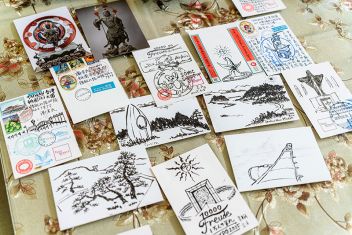
Remains of the Convento de Todos los Santos, built in the 17th century by Spanish missionaries, were discovered under a parking lot of the CSBC shipyard on Keelung’s Heping Island.
Some recent popular television series have drawn on history for their plots, including Seqalu: Formosa 1867 and Gold Leaf. If you found these stories interesting, you are sure to find Keelung as portrayed by José Eugenio Borao Mateo equally fascinating. That is because his research is not simply an exploration of the past, but also tells the story of the amazing reunion in Taiwan of “a new immigrant of Spanish ancestry” and “Spaniards from history” after a hiatus of more than 300 years.
Professor José Eugenio Borao Mateo, a long-time teacher in higher education, first came to Taiwan in 1989 on a teaching exchange program between the Universidad de Navarra and Tamkang University. Borao Mateo, who had long been interested in the connections between history and daily life, happened at the time to read in an encyclopedia that the Spanish had come to Taiwan in the 17th century, and this gave him inspiration for his historical research. He came to Taiwan and, unexpectedly, has remained here for more than 30 years.
No sign of San Salvador
When Borao Mateo first came to Taiwan, he decided to focus on historical sites left behind in Taiwan by early Spanish missionaries, explorers, and soldiers, which were mainly to be found on Heping Island just off Keelung. This small island at the northern tip of Keelung was much coveted during the Age of Discovery due to its special geographic location. In the past the island was “one of the gateways to northern Taiwan” and today it remains a “historical microcosm” of Keelung.
In those days, the Spanish were trying to limit Dutch expansion into Asia and consolidate their own superior position in global trade. This is why they came to Taiwan and built Fort San Salvador on today’s Heping Island (then known as Sheliao Island). This mirrored the Dutch construction of Fort Zeelandia in Tainan (Dayuan) in southern Taiwan, and the adage “Keelung in the north, Dayuan in the south” referred to these two historic citadels.
As a historian, Borao Mateo is very meticulous about gathering and collating historical documents. On his way to Taiwan, he stopped off in the Philippines to examine historical records there. After arriving in Taiwan, based on the documents he had, his first excursion was to Keelung to search for remains of the old fort left behind by the Spanish. However, while he set out in high spirits, assuming he would be able to see an impressive old structure, in fact he found nothing at all, and even local people knew nothing about it.

Since the Age of Discovery, maritime Keelung has been an important historical stage where people of different lands and backgrounds gather.
Promoting archaeology on Heping Island
Borao Mateo, who has always believed that the Keelung fort was in no way inferior to that in Tainan, first established the location of the Spanish bastion by comparing historical images. In 2002, he finally was able to bring in Lee Der-her, a professor in the Department of Civil Engineering at National Cheng Kung University, to use ground-penetrating radar to detect the position of the old fortress. It turned out to be under the fitting-out shop on the western side of the No. 1 dry dock of a shipbuilding company, CSBC Corporation, Taiwan.
In 2011, working through a program of Taiwan’s National Science Council (today the Ministry of Science and Technology) called “From the Renaissance to the Neolithic: The Spanish Fortress of Kelang (Taiwan) and Its Earlier Austronesian and Prehistoric Environment,” Borao Mateo arranged for members of the Spanish National Research Council (Consejo Superior de Investigaciones Científicas, CSIC) to come to Taiwan and conduct an international collaborative project with the Academia Sinica’s Institute of History and Philology. Borao Mateo handled the interpretation of historical documents, while the archaeological work was carried out by Spanish archaeologist María Cruz Berrocal and Academician Tsang Cheng-hwa of the Academia Sinica. Finally, archaeological work was underway on Heping Island!
However, while it was initially intended that Fort San Salvador would be the first site to be excavated, there were delays in getting permission from CSBC because of the current buildings on the site. Therefore, working within the area where CSBC did allow them to dig, the team turned their focus to the company parking lot, which also potentially had historic remains beneath it. The following year, Borao Mateo reinterpreted a 1654 map of northern Taiwan and suggested that the archaeological team go “25 meters from the tree, following the edge of the parking lot, and begin digging there.”
As a result they were able to discover the remains of the Convento de Todos los Santos (Convent of All Saints) built in the 17th century by Dominican friars. In addition, the Spanish archaeological team led by María Cruz Berrocal also found a Catholic cemetery attached to the convent’s church.
The dig unearthed strata from various past eras, including the Neolithic, the Iron Age, and the Age of Discovery. Borao Mateo, working with his students and the archaeologist Hung Hsiao-chun, gathered these discoveries into a book entitled Recovering the Past of Jilong: New Archaeological Findings from Heping Island of Northern Taiwan.
Heping’s significant past
Borao Mateo gradually withdrew from the archaeological team in 2013, but as a historian he retains enormous enthusiasm for Heping Island and Keelung.
Barao Mateo echoes the words of his own teacher, the historian Enric Ucelay-Da Cal, who told him that it doesn’t matter whether you study the history of a whole country or of a village of 600 persons; what matters most is whether you address a universal problem.
In other words, there is still great historical value today in looking back at 17th-century Heping Island and researching a settlement of only 600 indigenous people against the backdrop of a country that faces out on a great ocean. “Certainly, this early history of Keelung can be studied as something of universal value because it signifies the human encounter of different cultures, with different understanding of a territory [in terms of] dominion and occupation, but in which they have to live together,” says Borao Mateo. “It is the mutual effort of knowing ‘the other,’ followed by cultural evaluation on both sides, and admitting that ‘the other’ has things to teach you or to show you. This is universal not only in space but in time. These are issues that somehow are replicated even in modern life.”

In Borao Mateo’s eyes, Keelung is full of historical interest, and he hopes that more local people will become familiar with the stories behind this city.
A city in need of a historian
Borao Mateo has said: “Keelung is a city with no history.” It is only when you ask him for more detail that you discover the true meaning of this surprising statement: He is by no means saying that Keelung has no historical roots, but rather—because he is well versed in the local history and culture—that he feels it is a pity that there are so very few books available that focus on this history, and people lack an adequate understanding of the city’s past.
Borao Mateo himself has produced a major work called Spaniards in Taiwan (comprising Volume 1: 1582–1641 and Volume 2: 1642–1682), which presents Spanish historical documents with English translations, as well as the book The Spanish Experience in Taiwan, 1626–1642: The Baroque Ending of a Renaissance Endeavor, published in both English and Chinese. They are both of great educational value.
Recently one of Borao Mateo’s students, Emilia Hu, got together with illustrator Huang Zi-yan to produce the children’s book Pedro’s Necklace. It is about Heping Island in the Age of Discovery and describes the interaction between the Basay indigenous people and the Spanish. Borao Mateo served as a consultant for the book, which can be seen as an indirect response to his hopes that someone would write a book about Keelung.
“A place like this is worth writing about.” For Borao Mateo, Keelung is still awaiting a historian who can marshal diverse sources from the distant past to the present and write a book that is thorough and solidly founded in historical knowledge, yet is also accessible to the general reading public. “In my opinion, such research can be conducted under the concept of the ‘city-harbor,’ in the same way that the history of Taiwan could be modeled under the concept of ‘insularity,’” says Barao thoughtfully.
For more pictures, please click《Tracing the Spanish Presence in Taiwan: The Archaeology of Heping Island》











